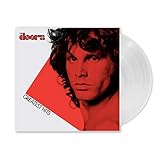The Doors Vinyl Records Lps For Sale
Check out these new and used The Doors vinyl records LPs for sale. We recommend starting your The Doors vinyl collection with the essential albums Strange Days, Waiting For The Sun and The Doos. Our inventory is always changing, so check back often, or browse our list of vinyl records for sale from rock musicians.
L.A. Woman
6% OffWaiting for the Sun (50th Anniversary Expanded Edition)
20% OffGreatest Hits - Exclusive Limited Edition White Colored Vinyl LP
$47.95 (as of June 29, 2025 06:13 GMT +00:00 - More infoProduct prices and availability are accurate as of the date/time indicated and are subject to change. Any price and availability information displayed on [relevant Amazon Site(s), as applicable] at the time of purchase will apply to the purchase of this product.)The Soft Parade (50th Anniversary Remaster Edition)
12% OffThe Greatest Hits[LP]
Weird Scenes Inside the Gold Mine
25% OffThe Doors (50th Anniversary Deluxe Edition)
L.A. Woman (50th Anniversary Deluxe Edition)
34% Off13
Live in New York
28% Off
The Doors: Light My Fire and Beyond
A Prelude to Psychedelic Rock
Formation and Early Days (1965-1966) The Doors, consisting of Jim Morrison, Ray Manzarek, Robby Krieger, and John Densmore, emerged from the vibrant music scene of Los Angeles in 1965. Their amalgamation of rock, blues, and poetry set them apart. In 1966, they signed with Elektra Records, embarking on a journey that would redefine the landscape of rock music.
Debut Album: “The Doors” (1967)
Break on Through to the Other Side “The Doors” (1967), the eponymous debut album, catapulted the band into the spotlight. With iconic tracks like “Break on Through (To the Other Side)” and “Light My Fire,” the album showcased Morrison’s magnetic stage presence and the band’s unique sound. The extended organ and guitar solos on “Light My Fire” became a symbol of the burgeoning psychedelic rock movement.
Notable Tracks:
- “Break on Through (To the Other Side)”
- “Soul Kitchen”
- “The Crystal Ship”
- “Light My Fire”
“Strange Days” (1967): Exploring the Psychedelic Realm
Echoes of Psychedelia “Strange Days” (1967) delved deeper into the psychedelic realm. With Morrison’s cryptic lyrics and Manzarek’s innovative keyboard work, the album expanded the band’s sonic palette. The haunting “People Are Strange” and the epic “When the Music’s Over” solidified The Doors’ status as pioneers of psychedelic rock.
Notable Tracks:
- “People Are Strange”
- “Love Me Two Times”
- “Moonlight Drive”
- “When the Music’s Over”
“Waiting for the Sun” (1968): A Ray of Light
Commercial Success and Experimental Shifts “Waiting for the Sun” (1968) marked a commercial peak for The Doors. The album featured the hit single “Hello, I Love You,” reaching No. 1 on the Billboard Hot 100. While continuing their psychedelic explorations, the band also embraced a more stripped-down sound with tracks like “Five to One.”
Notable Tracks:
- “Hello, I Love You”
- “The Unknown Soldier”
- “Five to One”
- “Spanish Caravan”
The Experimental Journey Continues
“The Soft Parade” (1969): A Departure “The Soft Parade” (1969) witnessed The Doors’ departure from their earlier sound. Experimenting with brass and string arrangements, the album displayed a more eclectic approach. Tracks like “Touch Me” and “Wild Child” demonstrated the band’s versatility, although some fans found the departure unsettling.
Notable Tracks:
- “Touch Me”
- “Wild Child”
- “Shaman’s Blues”
- “The Soft Parade”
A Darker Turn: “Morrison Hotel” (1970)
Back to the Roots “Morrison Hotel” (1970) marked a return to the band’s bluesy roots. Embracing a raw and gritty sound, the album included powerful tracks like “Roadhouse Blues” and “Peace Frog.” Morrison’s vocals showcased a renewed intensity, hinting at a darker turn in his personal life.
Notable Tracks:
- “Roadhouse Blues”
- “Peace Frog”
- “Ship of Fools”
- “Indian Summer”
“L.A. Woman” (1971): The Final Act
A Blues-Rock Masterpiece “L.A. Woman” (1971) emerged as a blues-rock masterpiece and a fitting swan song for Jim Morrison. The album’s title track, with its driving rhythm and Morrison’s soulful vocals, became an instant classic. “Riders on the Storm,” the last song recorded with Morrison, showcased the band’s ability to create atmospheric and cinematic soundscapes.
Notable Tracks:
- “L.A. Woman”
- “Riders on the Storm”
- “Love Her Madly”
- “The Changeling”
Jim Morrison’s Departure and the Legacy Lives On
The Loss of a Poet Jim Morrison’s untimely death in 1971 marked the end of an era. His charismatic stage presence, poetic lyrics, and enigmatic persona left an indelible mark on rock history. The remaining members continued briefly as a trio before disbanding in 1973.
Posthumous Releases and Live Albums In the aftermath of Morrison’s death, The Doors released several posthumous albums, including “Other Voices” (1971) and “Full Circle” (1972). Live albums like “Absolutely Live” (1970) and “An American Prayer” (1978) captured the band’s dynamic performances.
Individual Pursuits and Reunion
Solo Ventures and Collaborations After The Doors disbanded, each member pursued individual projects. Manzarek, Krieger, and Densmore ventured into solo careers and various collaborations, keeping the flame of The Doors alive in their own ways.
Reunion Without Morrison In 2000, Manzarek and Krieger reunited as The Doors of the 21st Century, later shortened to Riders on the Storm. The absence of Morrison led to controversy, but the band continued to perform classic Doors songs with other vocalists.
Legacy and Enduring Influence
Hall of Fame and Cultural Impact The Doors were inducted into the Rock and Roll Hall of Fame in 1993. Their influence on rock, blues, and psychedelic music remains profound. The band’s cultural impact is evident in films, books, and countless covers of their iconic songs.
“The End”: A Cinematic Legacy The Doors’ music has become synonymous with film, particularly Francis Ford Coppola’s “Apocalypse Now” (1979), where “The End” serves as a haunting backdrop to the film’s opening sequence. The song’s inclusion in films has contributed to its timeless allure.
Echoes in the Halls of Perception
Enduring Appeal and Timeless Relevance The Doors’ music continues to resonate across generations. From the rebellious spirit of “Break on Through” to the mysterious allure of “Riders on the Storm,” The Doors’ catalog remains a journey through the halls of perception, inviting listeners to explore the depths of rock and psychedelia.
Infinite Riders on the Storm As The Doors’ legacy endures, their music remains a beacon for those who seek a transcendent experience. The interplay of Morrison’s poetic lyrics, Manzarek’s mesmerizing keyboards, Krieger’s inventive guitar work, and Densmore’s dynamic percussion forms a tapestry that transcends time—an infinite ride on the storm of musical exploration.





![The Greatest Hits[LP] #1](https://m.media-amazon.com/images/I/51tEwi4ChXL._SL100_.jpg)













![Legend [Vinyl] #1](https://m.media-amazon.com/images/I/611La+6Hi9L._SL100_.jpg)
![Legend [Vinyl] #2](https://m.media-amazon.com/images/I/31nfAYBov8L._SL100_.jpg)
![Legend [Vinyl] #3](https://m.media-amazon.com/images/I/21h7ykrSuuL._SL100_.jpg)
![Legend [Vinyl] #4](https://m.media-amazon.com/images/I/318kzRTVolL._SL100_.jpg)
![Legend [Vinyl] #5](https://m.media-amazon.com/images/I/31vjgY6+u5L._SL100_.jpg)




![Back to Black [Vinyl] #1](https://m.media-amazon.com/images/I/61Db7-hQGKL._SL100_.jpg)


![[Exquisite Appearance] Built from wood and metal materials with a unique sense of layering; The streamlined corner design is truly atmospheric and stylish(Note: long hold the start button to turn the power on, and press again to start) [All in 1] Thi...](https://m.media-amazon.com/images/I/41vovGjFkeL._SL160_.jpg)






































